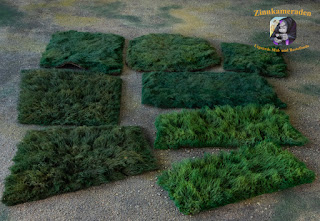Here is another little "How To" from me - this time how I make unpaved roads using fake fur again.
And remember:
There are countless techniques to achieve the same (and better) results, but this is the one that:
a) works best for me
b) is a good compromise between effort and time
I would recommend testing different techniques, as I did, as this is the only way to find the technique that suits you best.
A few things to keep in mind:
- It is advisable to wash the fabric thoroughly beforehand to remove any residue that could prevent the colour from sticking to the fabric later.
- Each layer of colour must be applied repeatedly from all sides and then always brushed in immediately. It is better to repeat this several times than to apply too much colour at once, because then the hairs of the fake fur will clump together!
- The colour must be allowed to dry between the individual layers, but the time can be shortened with a hair dryer.
- Take your time and don´t rush through the needed steps.
But now without further ado:
The required tools: shaver, scissors, various brushes and combs in different sizes, rolling pin, various spatulas.
My template to ensure that the connections between the roads fit together smoothly - I settled for 1cm for each of the two road banks and 6cm for the track itself, that´s 8cm in total (works for 15mm and 28mm for me).
Cut the fur to size and then gradually trim it to the desired length using a shaver, in case of the road banks i settled for about 9mm. Finishing trimming with a scissor so the banks don´t look to regular in height.
The base colour is applied - only apply a little colour at a time, comb it in immediately and repeat this step from different directions until satisfied with the look.
Highlights added - I wanted to achieve a rather dusty look for the roadsides and added yellow and sand tones accordingly.
As soon as everything is dry, the acrylic caulking is applied thinly with a spatula and then pressed firmly into the fabric. Both of these steps are extremely important to ensure that the acrylic holds well later and does not crack!
Then sprinkle on a sand mixture and carefully smooth with a damp roller - you can now press tracks into the still damp mass as desired using an old vehicle/tank.
Next step is a thinly applied Brown wash ...
... followed by drybrushing with different tones of brown, ochre and sand.
The final step is a drybrush with a pure sand-coloured tone, as I want my roads to have a rather dry, dusty look, as is typical for unpaved roads in the Mediterranean region.
And here are a few pictures of the final result after following the above steps so far:
As you can see, the transitions between the individual segments of my roads are hardly noticeable.
I hope this little guide is helpful for some of you to make your very own version of flexible unpaved roads. If there are any open questions, I will be happy to try and answer them.

























































